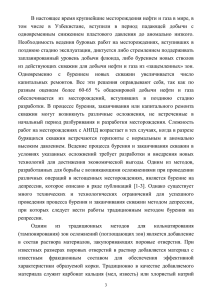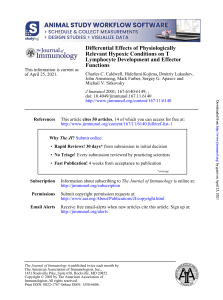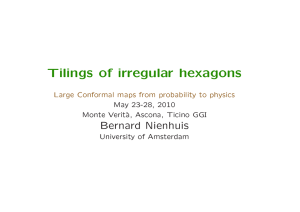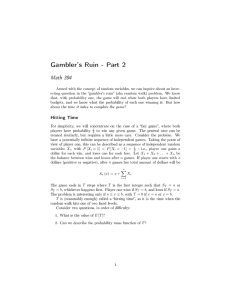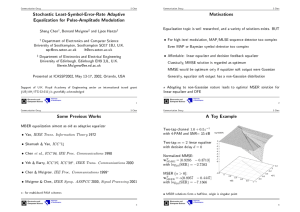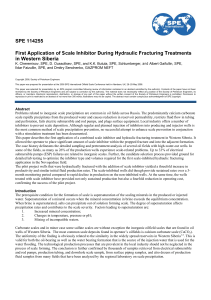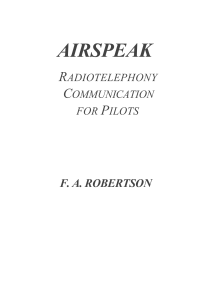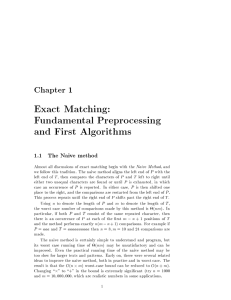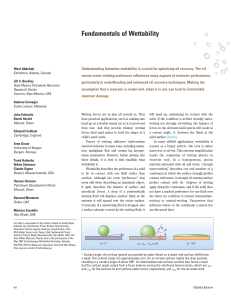ж р р зв д р ж л я р п к сш сшр
advertisement
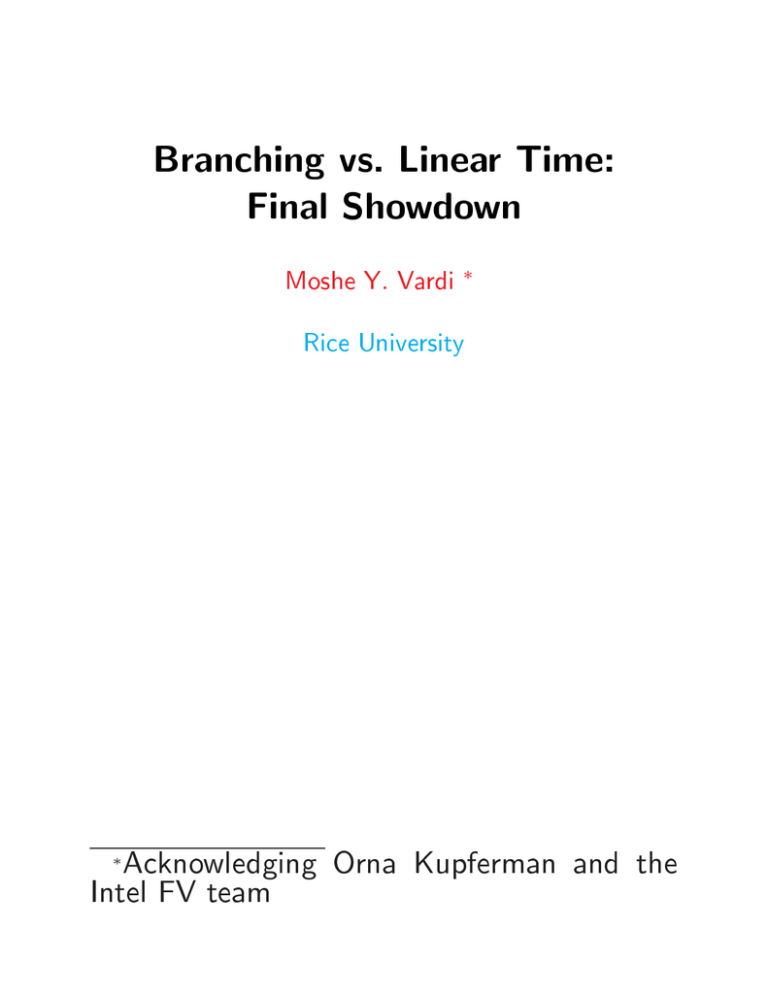
Branhing vs. Linear Time:
Final Showdown
Moshe Y. Vardi Rie University
Aknowledging Orna Kupferman and the
Intel FV team
Formal Veriation Today
Veriation as debugging: Failure of veriation
identies bugs.
Both speiations and programs attempt to
formalize informal requirements.
Veriation ontrasts two independent formalizations.
Failure of veriation reveals inonsisteny between
the two formalizations.
Model heking: unommonly eetive debugging
tool
a systemati exploration of the design state spae
good at athing diÆult \orner ases"
1
Designs are Labeled Graphs
Key Idea: Designs an be represented as transition
systems (nite-state mahines)
Transition System: M
= (W; I; R; F; )
W : states
I W : initial states
R W W : transition relation
F
:W
W : fair states
!
P owerset(P rop): Observation funtion
Fairness: An assumption of \reasonableness" { restrit
attention to omputations that visit F innitely often,
e.g., \the hannel will be up innitely often".
2
Speiations
Linear-Time
omputations.
Speiations:
properties
of
Examples:
\No two proesses an be in the ritial setion at
the same time." { safety
\Every request is eventually granted." { liveness
\Every ontinuous request is eventually granted."
{ liveness
\Every repeated request is eventually granted." {
liveness
3
Linear Temporal Logi
Linear Temporal logi (LTL): logi of temporal
sequenes
Main feature: time is impliit
next ': ' holds in the next state.
eventually ': ' holds eventually
always ': ' holds from now on
' until : ' holds until
holds.
4
Examples
always not (CS1 and CS2): mutual exlusion (safety)
always (Request implies eventually Grant): liveness
always (Request implies Request until Grant):
liveness
always eventually Request implies eventually Grant:
liveness
5
Linear vs. Branhing
Linear time:
omputations
a system generates a set of
Spes: desribe omputations
Branhing time:
omputation tree
a program generates a
Spes: desribe omputation trees
6
Program Equivalene
P1:
P2:
Linear Time: P1 P2
Branhing Time: P1 6 P2
7
Temporal Logis
Spes: Every request is eventually granted
Linear (LTL): always (Request implies eventually
Grant)
Branhing (CTL):
eventually Grant)
8
always (Request implies
8
8
LTL vs. CTL: The Long Debate
Pnueli: 1977
Lamport: \`Sometimes' is sometimes `Not Never"',
1980
Emerson and Clarke: 1981
Ben-Ari, Pnueli, and Manna: 1983
Pnueli: 1985
Emerson and Lei: \Branhing-time logi strikes
bak", 1985
Emerson and Halpern: \`Sometimes' and `Not
Never' Revisited", 1986
Conlusion: Philosophially, a draw.
9
LTL vs. CTL: Expressiveness
Caveat: Linear and branhing logis are inomparable.
LTL: eventually always P { in every omputation P
is ultimately true.
CTL: (8 eventually 8 always P) { P will stabilize at
true within a bounded amount of time.
General Assessment:
Interesting CTL-LTL: \small"
Interesting LTL-CTL: \large"
10
LTL vs. CTL: Complexity
Model-Cheking Problem: Does T satisfy '?
j
T j = n, j'j = m
Time Complexity:
CTL: O(nm) [CES'86℄
LTL: O(n2m) (PSPACE-omplete) [LP'86,SC'85℄
Conlusions:
Low omplexity in jT j
CTL exponentially easier than LTL
11
Pragmatis
Folk Wisdom: CTL is less expressive than LTL, but
CTL is superior to LTL omputationally.
Model Cheking in pratie: CTL usage dominates
CTL: SMV, VIS, RuleBase, ChekO, Motorola
Linear Time: Cadene's SMV, FormalChek, SPIN,
Intel
Note: Linear Time 6= LTL!
12
CTL vs. LTL: A Fresh Perspetive
Expressiveness
Computational Complexity
Compositionality
Pragmatis
13
Expressiveness
IBM's Experiene:
IBM J. of Researh and Development: Formal
Veriation Made Easy, 1997
\We found only simple CTL equations to
be intuitively omprehensible; nontrivial CTL
equations are hard to understand and prone to
error."
CAV'98: On The-Fly Model Cheking, 1998
\CTL is diÆult to use for most users
and requires a new way of thinking about
hardware."
Fats:
Sugar, RuleBase's spe language, tries to hide away
CTL
In partie, users write \linear" CTL formulas.
14
Example
LTL:
{ next eventually P
{ eventually next P
Both formulas assert that P holds in the strit
future.
CTL:
{
{
next 8 eventually P
8 eventually 8 next P
8
Are these formulas equivalent? What do they say?
How do they relate to the LTL formulas?
15
Algorithmi Foundations
Basi Graph-Theoreti Problems:
Reahability: Is there a nite path from I to F ?
Fair Reahability: Is there an innite path from I
that goes through F innitely often.
Note: These paths may orrespond to error traes,
e.g., deadlok and livelok.
16
CTL Model Cheking
Basi Algorithm:
Iterated reahability analysis (i.e., reahability and
fair reahability)
Simple reursion on struture of formulas,
e.g., 8 always 9 eventually P involves a
reahability omputation followed by a fairreahability omputation.
Computational omplexity is linear in size of design
and size of spe.
17
Automata on Innite Words
Buhi Automaton: A = (; S; S0; ; F )
Alphabet:
States: S
Initial states: S0 S
Transition relation: S S
Aepting states: F
S
Input word: a0; a1; : : :
Run: s0; s1; : : :
s0 2 S0
(si; ai; si+1) for i 0
2
Aeptane: F visited innitely often
18
Temporal Logi vs. Automata
Paradigm: Compile high-level logial speiations
into low-level nite-state language
The Compilation Theorem: [V.-Wolper℄
Given an LTL formula ', one an onstrut an
automaton A' suh that a omputation satises
' if and only if is aepted by A'. Furthermore, the
size of A' is at most exponential in the length of '.
Example:
always eventually P:
eventually always P
19
LTL Model Cheking
The following are equivalent:
M satises '
all omputations in L(M ) satisfy '
L(M ) L(A')
L(M jjA:') = ;
Bottom Line: To hek that M satises ', ompose
M with A:' and hek whether the omposite system
has a reahable (fair) path. Veriation redues to
reahability or fair reahability.
Intuition: A:' is a \wathdog" for \bad" behaviors.
A reahable (fair) path means a bad behavior.
20
Computational Complexity
Worst ase: linear in the size of the design spae and
exponential in the size of the speiation.
Real life: Speiation is given in the form of a list
of properties '1; ; 'n. It suÆes to hek that M
satises 'i for 1 i n.
Moral: There is life after exponential explosion.
The real problem: too many design states { symboli
methods needed
21
CTL vs. LTL: Comparison
Invalid Comparison: worst ase of an inexpressive
logi against worst ase of an expressive logi
Valid Comparison: ompetitive analysis { ompare
performane of CTL and LTL model hekers on
formulas that are in both logis
{ always eventually P
{ 8 always 8 eventually P
Empirial Claim: On formulas in LTL\CTL, CTL and
LTL model hekers behave similarly, and if they don't,
you an make them (see work by Bloem-Ravi-Somenzi
in CAV'99 and by Maidl in FOCS'00).
22
Compositional Veriation
State Explosion:
T = T1jj : : : jjTk
j
T j = jT1j : : : jTk j
9
P1 satises 1 =
P2 satises 2 P1 P2 satises
C ( ; 1; 2) ;
k
P1kP2: omposition of P1 and P2
C ( ; 1; 2): logial ondition relating , 1, and
2
Advantage: apply model heking only to the
underlying modules, whih have smaller state spaes.
23
Assume-Guarantee Veriation
M guarantees
assuming ' { h'iM h i: for an
arbitrary M 0, if M kM 0 j= ', then M kM 0 j=
trueiM1h'1i
htrueiM2 h'2 i
h
'2iM1h 1i
h'1 iM2 h 2 i
h
9
>
=
>
;
Fat: Cheking h'iM h
CTL and LTL [KV'95℄
trueiM1kM2h 1 ^ 2i
h
i
is exponential in ' for both
24
It Gets Worse!
CTL is too weak:
Cruial: Assumptions have to be strong enough to
ensure guarantee; LTL assumptions may be needed
for a CTL guarantee.
But: The ombination of a CTL guarantee and an
LTL assumption involves a doubly exponential ost
in omputational omplexity.
In pratie
CTL-based
model hekers do not support
ompositional reasoning
Veriers engage in unsafe reasoning when using
CTL-based model hekers beause assumptions are
always needed.
Ken MMillan: \In ompositional reasoning use LTL"
(Cadene's SMV uses linear time).
25
Pragmatis
The linear-time view has numerous other advantages:
Renement: L(Timp) L(Tspe) { linear view
Abstration: L(Ton) L(Tabst) { linear view
Dynami validation: only linear view available
Counterexamples: validators want traes
Searh linear
ounterexamples of predetermined size size.
Bounded
Model
Cheking:
26
What about Conurreny Theory?
But: CTL haraterizes bisimulation!
So what?
Bisimulation is about struture
8
next 8 eventually P vs. 8 eventually 8 next P
Model heking is about behavior
next eventually P vs. eventually next P
Dierene between ab + a and a(b + ) beome
lear in a state-based model, in whih deadlok is
modeled expliitly
27
Is LTL The Answer?
Question: \Ok, ok. You made your point. Can we
nish the talk and go with LTL then?"
Answer: \Not so fast. Let us reonsider ompositional
reasoning."
28
Compositional Reasoning Revisited
Cruial Points:
Assume-guarantee reasoning is the prevalent way of
reasoning about ompliated systems { you always
need assumptions.
When trying to hek that \M guarantees
assuming '", you an weaken , but you have
to make ' as strong as needed.
Corollary 1: Your spe language for assumptions
needs to be as expressive as your hardware modeling
language.
Cruial Point:
Your assume-guarantee reasoning is not sound,
unless you guarantee your assumptions { danger
of false positives.
Corollary 2: Your spe language needs to be as
expressive as your hardware modeling language.
Fat: LTL is too weak { annot express nite-state
mahines.
29
Beyond Naive Hardware Modeling
Assumptions: abstrated hardware
Replae gorry detail by nondeterminism
Eliminate possible runs by using fairness
Note: Nondeterministi FSMs with fairness onditions
are Buhi automata, whih express !-regularity (more
expressive than LTL).
Question: Can we make Buhi automata into a spe
language?
30
What Is Logi?
Features of Logi:
Closure under Boolean onnetives: if ' and
formulas, then ' ^ , ' ! are formulas.
are
Closure under substitution: atomi propositions an
be replaed by formulas; if always p and eventually q
are formulas, then always eventually q is a formula.
31
Extended Temporal Logi
ETL:
Start with Buhi automata where the labels are
atomi propositions
Close under Boolean onnetives (ompositionality)
Close under substitutions (re-usability)
Note: Closure under Boolean onnetives and
substitutions is not neessary for expressiveness.
FormalChek does not have it.
Example:
32
ETL: Pros and Cons
Advantages:
Expressive enough for assume-guarantee reasoning
Pnueli, 1986: \In order to perform ompositional
speiation and veriation, it is neessary to have
the full power of ETL."
Formalism (FSMs) is very familiar to hardware
designers
Worst-ase omplexity same as LTL.
Disadvantages:
Nesting of mahines is oneptually diÆult
No experimental validation (yet)
Complementation is known to be diÆult
Bottom Line: More researh needed
33
Other Formalisms
-alulus:
{ One temporal onnetive (next) plus xpoint
operators
{ Unreadable: always eventually P
(gfp X )(lfp Y )(X next(P Y ))
^
_
QPTL:
{ LTL plus propositional quantiers
{ Example:
( X )(X always(X
9
^
$
next X ) always(X
:
^
!
{ Complexity: nonelementary (unbounded stak of
exponentials)!
34
P ))
A Pragmati Proposal
Competing demands on real languages:
Expressiveness: supports ompositional reasoning
Usability: an be used by veriation engineers
Closure: supports speiation libraries
Implementability: feasible implementation
History: onsisteny with prior experiene of users
35
FTL: ForSpe Temporal Logi
ForSpe: Intel's new formal speiation language
key features:
linear-time logi, with fully ! -regularity
rih set of operations of Boolean and arithmetial
operations
time windows (P until
regular events
[10; 15℄ Q)
always((req; ( ak); ak) triggers
:
(true+; grant; ( rel); rel))
:
universal propositional quantiation
hardware-oriented features (multiple loks and
resets)
36
Did We Waste 20 Years on CTL?
Absolutely not!
Usefulness of model heking demonstrated
Symboli reahability
algorithms
and
fair
reahability
CTL model hekers as bak-end for lineartime model hekers (Cadene's SMV and Intel's
ForSpe)
CTL is useful in heking orret modeling, e.g.,
8 always 9 true says that there is a fair path from
every state.
Branhing time is appropriate in game-theoreti
settings, e.g., AI planning and ontroller synthesis.
37
Conlusions
In spite of 20 years of researh, this issue has not
been resolved yet
CTL is learly not adequate as a spe language
LTL is better, but has weaknesses
FTL is a strong industrial ontender
My bottom line:
Let's lose the linear-time vs.
debate: linear time won!
branhing time
Let's re-open the linear-time vs. linear-time debate
(e.g., FTL vs. FormalChek vs. ITL).
Let's develop linear-time model heking tehnology.
38
